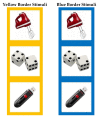A Comparative Perspective on Three Primate Species' Responses to a Pictorial Emotional Stroop Task
- PMID: 33668170
- PMCID: PMC7995981
- DOI: 10.3390/ani11030588
A Comparative Perspective on Three Primate Species' Responses to a Pictorial Emotional Stroop Task
Abstract
The Stroop effect describes interference in cognitive processing due to competing cognitive demands. Presenting emotionally laden stimuli creates similar Stroop-like effects that result from participants' attention being drawn to distractor stimuli. Here, we adapted the methods of a pictorial Stroop study for use with chimpanzees (N = 6), gorillas (N = 7), and Japanese macaques (N = 6). We tested all subjects via touchscreens following the same protocol. Ten of the 19 subjects passed pre-test training. Subjects who reached criterion were then tested on a standard color-interference Stroop test, which revealed differential accuracy in the primates' responses across conditions. Next, to test for an emotional Stroop effect, we presented subjects with photographs that were either positively valenced (a preferred food) or negatively valenced (snakes). In the emotional Stroop task, as predicted, the primates were less accurate in trials which presented emotionally laden stimuli as compared to control trials, but there were differences in the apes' and monkeys' response patterns. Furthermore, for both Stroop tests, while we found that subjects' accuracy rates were reduced by test stimuli, in contrast to previous research, we found no difference across trial types in the subjects' response latencies across conditions.
Keywords: Stroop effect; affect; attentional bias; cognitive bias; emotions; snake detection theory; touchscreen; welfare; zoo.
Conflict of interest statement
The authors declare no conflict of interest.
Figures







References
-
- Webster J. Animal Welfare: Limping Towards Eden. Blackwell Publishing; Oxford, UK: 2005. (UFAW Animal Welfare Series).
-
- Fraser A.F., Broom D.M. Farm Animal Behaviour and Welfare. CAB International (formerly Baillière Tindall); Wallingford, UK: 1990.
-
- Mellor D.J., Beausoleil N.J. Extending the ‘Five Domains’ Model for Animal Welfare Assessment to Incorporate Positive Welfare States. Anim. Welf. 2015;24:241–253. doi: 10.7120/09627286.24.3.241. - DOI
Grants and funding
LinkOut - more resources
Full Text Sources
Other Literature Sources
Medical

